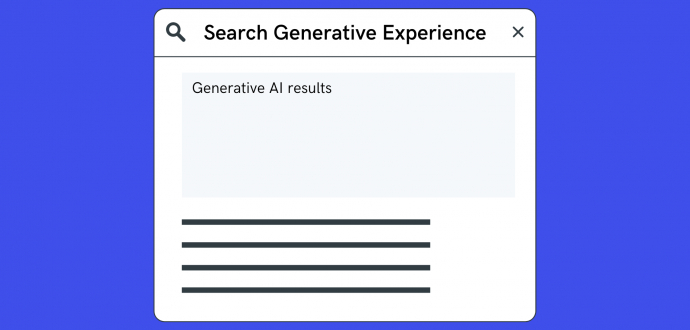Google’s Search Generative Experience (SGE): Main Things to Know

You might already know that 68% of online experiences start with a search. Yet, even something we got used to is beginning to change.
Common search and approaches to it begin to be more developed and offer more opportunities to users. Introduction of Search Generative Experience (SGE) - Google’s generative AI-fueled search - allows people to have a better experience.
And as only 28% of US adults are ready to switch to AI-enabled search, we’ve decided to make a deeper dive into SGE.
In this article, we will discuss Google’s way to AI-powered search, how this model was trained, and what you can get when enabling AI search for browsing.
SGE’s prerequisites
Let’s delve into history to understand Google’s development history. That will help us understand why the search engine giant has decided to turn to AI technology.
1998 (September the 4th) - it’s the date Larry Page and Sergey Brin created Google. The founders' initial idea was to "make all information accessible and useful worldwide."
And Google is keeping this motto through the years. We all witnessed how approaches to sites’ evaluations had been changing to provide the most fitting and helpful results on SERP.
2001 - Google introduced its first machine learning algorithm applied to spelling correction. That allowed users to get the right search results regardless of mistakes or typos.
2019 - implementation of Bidirectional Encoder Representations from Transformers, widely known as BERT.
BERT is a neural network-based technique for NLP. Put simply, this model lets Google understand words in relation to each other, not separately. That’s extremely helpful when it comes to understanding user’s search intent.
2021 - introduction of Multitask Unified Model (MUM). This large language model (LLM) is 1,000 times more powerful compared to BERT.
This way, MUM not only understands information but is also trained to differentiate between 75 languages. As MUM is multimodal, it also allows it to ‘read’ data not only from text but also from images. In the future, Google is planning to train it to understand audio and video.
2023 - Google introduced Search Labs through which SGE was available. The company planned to hold the experiment up to December 23. Thus, it seems like it’s still rolling. Which clearly shows AI implementation is Google’s priority.
Nevertheless, we need to cover the latest Google AI adoption - SGE, in more detail.
Basically, SGE will change your common search experience thanks to generative AI use. As a result, you will see the habitual search result page, yet with answers organized differently.
The goal of this update is to provide a better and more extended experience within a single search.
Users employing an experimental SGE search can ask more complex questions. After getting a gen AI-generated answer, a user can ask the model to follow up on the question and give more details. Moreover, it’ll be possible to choose from the most relevant additional questions to get more information.
However, SGE offers another option. Users transform their requests into AI-generated imagery.
How can you use SGE? Well, you can refer to labs.google.com/search to try and test the model. Yet, consider that you need to have a personal Google account (organization accounts do not qualify) updated to the latest version. Also, there are some regional limitations.
SGE training
Though AI technology is getting more and more widely used, it still has limitations regardless of field of application.
Google also leaves a note to users employing SGE that information quality might vary. Anyway, as this model is still experimental, it requires research, data collection, and checking, as well as training.
Google does its best to improve and scale this approach ethically and responsibly. It leans towards its AI Principles and partners with policymakers, creators, experts, etc., to make it all safe.
SGE uses various LLMs to run. Yet, the models SGE utilizes are trained to serve specifically the search. So, the main purpose of this smart system is to provide high-quality web results that offer helpful and relevant information.
By training the models in a specific way, Google aims at degrading any inaccuracies.
To ensure SGE returns valuable results, Google has used human input. That ensures the model is trained to focus on elements like:
- Length,
- Format,
- Clarity.
But that’s not all. Google appealed to more well-known principles to train the model.
- Human raters. Google engaged Search Quality Raters to evaluate the SGE output. Though the rates did not directly influence the output, the results were considered to train further and improve the model.
- Focused analysis. Google uses a wide array of query sets. Yet, it pays significant attention to topics that can involve more risks or be more nuanced or complex. Safety and inclusion risks are also precisely considered by Google.
- Red-teaming. Google also takes close control over areas that don’t perform as expected. Thanks to this, it’s possible to identify bias issues, safety concerns, and more areas where Google can imply improvements.
As you can see, Google constantly works, trains, and improves SGE to cut problems like:
- Misinterpretation during corroboration,
- Bias,
- Hallucination.
What gen AI offers in search
But, of course, you might wonder how AI search - SGE - will be different from the habitual one.
Well, as soon as there is a chance to demonstrate the AI touch to the SERP, Google will do it. In turn, you will see an AI-powered snapshot with the most relevant information regarding your query.
This snapshot will be the starting point for your discovery journey. You will see the key points with an opportunity to expand the information by clicking helpful links. Besides, there will be related questions that you can also check to learn even more.
A new way to search by generative AI
On top of that, you can get more details by pressing the “Ask a follow up” button. After doing this, you will get further information about the same topic but from a different angle. That allows you to dive deeper into context and get more links for further investigation.
Except for searching for general answers or information, SGE provides better results for shopping and local searches. As SGE is built on Google’s Shopping Graph, users can receive more detailed and accurate results. This way, they can end up getting better suggestions and finding fitting products faster.
As always, Google stands for providing top-class user experience. That rule applies to the usual search and continues its evolution when SGE is utilized.
This way, SGE provides user-friendly results in recognizable Google’s UI yet carrying all the search engine’s experience about user behavior.
Creative ways to use SGE
Google emphasizes SGE’s effectiveness regarding creativity and productivity. That leads to a better information journey and higher quality.
The first significant SGE difference from the basic search is the ability to optimize long-running searches.
You will not only be able to find more complex information on your query and find products or service providers if needed but also get quick notes written for you.
This way, if you need to write a quick note, SGE will make a draft for you, while you can choose the length and the tone.
New ways to get inspired with generative AI in Search (Google)
Another pretty cool feature you can enjoy is the ability to create images. Though there are a lot of pictures on the Internet, sometimes it’s tough to find exactly what you need. That’s why you can find this feature extremely helpful.
You need to type your query as usual and see the results. After, you can press any picture to see further information. You can edit the chosen image to make it even more specific.
Or you can go directly to the Image search and type your request there.
New ways to get inspired with generative AI in Search (Google)
Conclusion
The appearance of Search Generative Experience (SGE) shows the rising popularity of AI technology. Though we earlier stated that not all users are ready to fully trust AI search, AI-powered search leads among the most requested AI-enabled products. 49% of US adults show high interest in it.
SGE is working in a testing mode, and it still has lots of biases to overcome.
However, we see a great potential for growth. SGE will be able to provide a qualitatively better user experience and solve more complex requests.
Our team is really curious about how AI will influence SEO in the near future and how SGE will become more widespread.
What do you think about SGE? Have you tried it? Leave your comments below.







